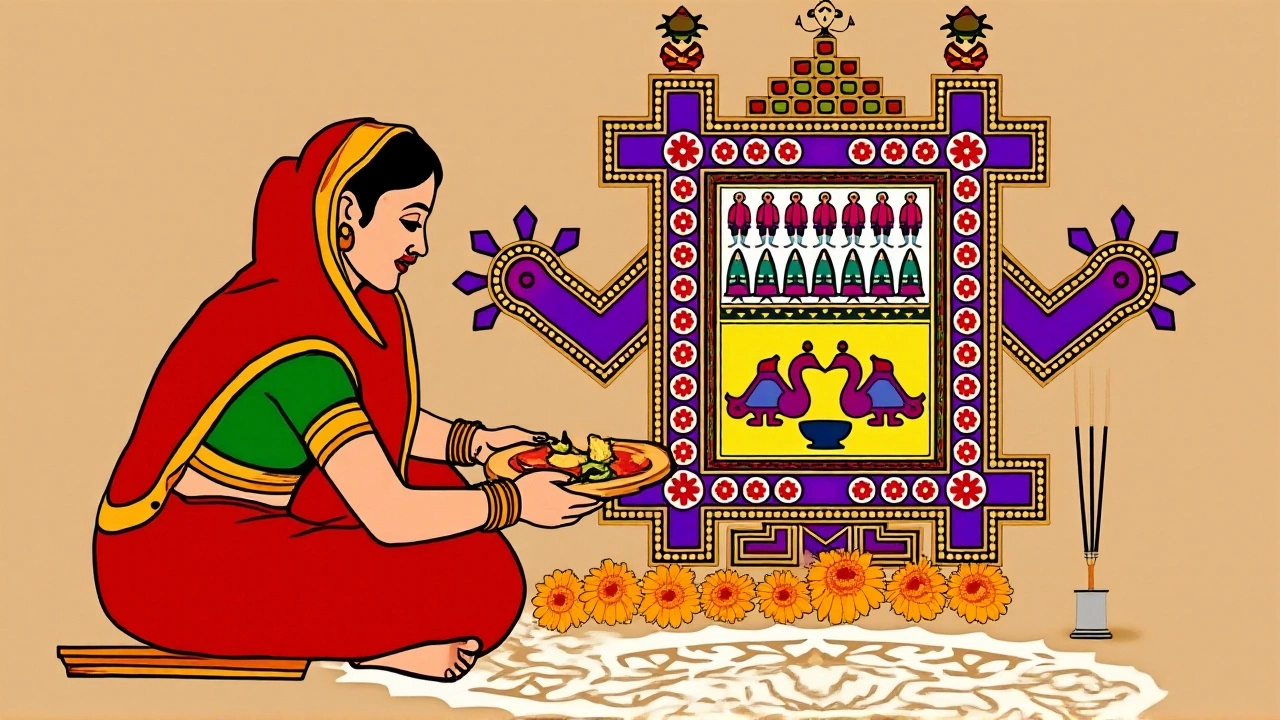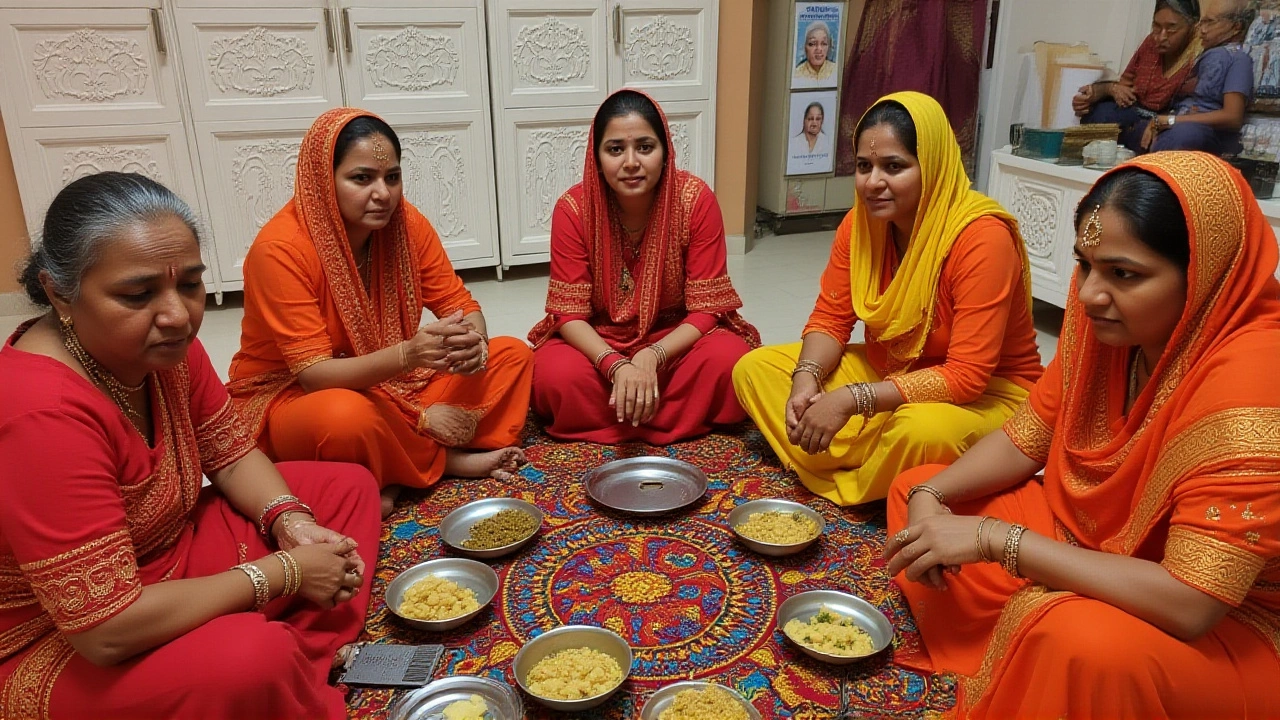When Goddess Ahoi Mata, revered as an incarnation of Parvati or Lakshmi, was invoked in the evening sky over Jhajjar, Haryana, a hush fell over the community of mothers gathered for Ahoi Ashtami 2025.
The ritual took place on Monday, October 13, 2025, as part of the Ahoi Ashtami 2025 celebration, when mothers listened to the traditional Vrat Katha before breaking their fast at the first sight of a star. According to the lunar calendar published by Drik Panchang, the Ashtami tithi began at 12:24 PM and ran until 11:09 AM the next day, while the puja muhurat was set between 5:53 PM and 7:08 PM.
Historical Roots of Ahoi Ashtami
The festival’s legend, traced back to ancient North Indian folklore, tells of a woman who inadvertently killed a lion cub while digging a foundation for her home. In a moment of remorse, she prayed to the divine mother, who forgave her and promised the blessing of healthy children. Over centuries, the story morphed into the Ahoi Ashtami Vrat Katha, a narrative recited by mothers to honor maternal love and protect their offspring.
Scholars note that the observance originally centered on male heirs, but modern practice—especially in states like Haryana, Uttar Pradesh, Punjab, and Rajasthan—has expanded to include all children. The shift mirrors broader social changes, with women asserting agency over family health and well‑being.
Today's Observances in Jhajjar‑Bahadurgarh
In the twin districts of Jhajjar and Bahadurgarh, the day started before sunrise. Women awoke early, filled earthen pots with water, and performed personal puja at home. The collective element began in community halls where the Vrat Katha was read aloud. "We felt a deep connection listening together," said one participant, Sunita Sharma, a mother of three.
After the story, the group moved to the open courtyard to watch the sky. As the sun dipped, the first star emerged at roughly 6:17 PM—timing corroborated by The Times of India. The fast was broken with a simple offering of rice, jaggery, and coconut, shared among families.
Timings and Astrological Calculations
Two major sources provided slightly different windows for the puja muhurat. While Drik Panchang listed 5:53 PM–7:08 PM, NKB Meditation suggested 6:05 PM–7:18 PM. Both agree the window spans about an hour and a quarter, ensuring flexibility for devotees.
Even the star‑sighting time varied: 6:17 PM per The Times of India versus 6:27 PM per NKB Meditation. Such discrepancies are common in Panchang calculations, which factor in local longitude, latitude, and daylight‑saving adjustments.
Adding to the celestial choreography, the moon rose late—11:20 PM according to Drik Panchang and 12:03 AM according to NKB—explaining why the fast ends with a star, not the moon, unlike Karwa Chauth.
Community Voices and Reactions
Local priests emphasized the day’s focus on compassion toward all living beings. "Ahoi Mata teaches us to protect the vulnerable—whether it’s a child, a bird, or a stray dog," explained Pandit Rajesh Kumar of the village temple.
Younger participants, however, voiced a hint of fatigue. "Staying away from water all day is tough, especially in October heat," admitted Anjali Singh, a 22‑year‑old engineering student. Yet she added, "The sense of unity and the blessings we receive are worth it."

Impact on Modern Hindu Mothers
Beyond the spiritual, the fast serves as a social anchor. In a region where gender ratios have long been a concern, the inclusive nature of Ahoi Ashtami sends a subtle message: the health of every child matters. Public health officials in Haryana have noted a modest rise in prenatal clinic visits coinciding with the festival season, suggesting that the ritual may encourage women to seek medical advice.
Economically, local vendors of earthen pots, fresh produce, and ritual items reported a spike in sales. The Jhajjar Handicrafts Cooperative saw a 12 % increase in orders for traditional clay vessels used in the puja.
Looking Ahead: Ahoi Ashtami in Future Years
With Diwali slated just eight days later on October 21, 2025, the Ahoi Ashtami fast acts as a preparatory spiritual cleanse for the larger festival of lights. Organizers are already planning a digital archive of the 2025 Vrat Katha, hoping to make the story accessible to diaspora communities via a livestream on MyJar platform.
Experts predict that as urbanization continues, collective storytelling may shift online, but the core sentiment—maternal devotion and a prayer for children’s longevity—will endure.
Frequently Asked Questions
What is the significance of star sighting in Ahoi Ashtami?
Unlike Karwa Chauth, which ends with the moon’s appearance, Ahoi Ashtami requires the first visible star after sunset. The star symbolizes hope and the divine mother’s gaze, marking the moment mothers break their fast to pray for their children’s wellbeing.
How do the timings differ between Drik Panchang and NKB Meditation?
Both sources agree on the overall window but differ by about 10‑15 minutes. Drik Panchang lists the puja muhurat from 5:53 PM to 7:08 PM, while NKB Meditation suggests 6:05 PM to 7:18 PM. Star‑sighting times also vary slightly—6:17 PM versus 6:27 PM—due to different astronomical algorithms.
Who can observe Ahoi Ashtami?
Traditionally a fast for mothers, the ritual welcomes any woman who wishes to pray for the health and longevity of her children—sons or daughters alike. In recent years, even men have joined community recitations to support the cause.
What are the key differences between Ahoi Ashtami and Karwa Chauth?
Both festivals involve fasting by married women, but Karwa Chauth ends at moonrise, while Ahoi Ashtami concludes when the first star appears. Additionally, Ahoi Ashtami’s prayers focus on the wellbeing of all children, not just spouses.
Will Ahoi Ashtami be celebrated next year on the same date?
Because the Hindu calendar follows lunar cycles, the Gregorian date shifts each year. In 2026, Ahoi Ashtami is expected around early November, still falling eight days before Diwali but on a different calendar day.

